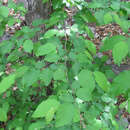More info for the terms:
association,
forest,
mesic,
xericKnowlton's hophornbeam is commonly found in oak (Quercus spp.) woodlands,
pinyon (Pinus spp.)-juniper (Juniperus spp.) woodlands, and lower
ponderosa pine (Pinus ponderosa) forest zones [
9]. In Texas it is a
component of the gray oak (Quercus grisea)-true pinyon (Pinus
edulis)-alligator juniper (Juniperus deppeana) association at 5,000 to
7,000 feet (1,524-2,133 m) and the ponderosa pine-Douglas fir
(Pseudotsuga menziesii) association at 6,000 to 7,500 feet (1,828-2,286
m). In Texas it is also associated with Texas madrone (Arbutus
texana), southwestern white pine (Pinus strobiformis), chinkapin oak (Q.
muehlenbergii), and bigtooth maple (Acer grandidentatum) [
18]. In
deciduous canyon woodlands of Guadalupe Mountains National Park, Texas,
Knowlton's hophornbeam will increasingly replace wavyleaf oak (Q.
undulata), alligator juniper, Riogrande cottonwood (Populus deltoides
ssp. wislizenii) and little walnut (Juglans microcarpa) as the moisture
gradient goes from xeric to mesic. Knowlton's hophornbeam is replaced by
bigtooth maple and chinkapin oak, especially on upper terraces, around
springs and in canyonheads [
6,
13].

